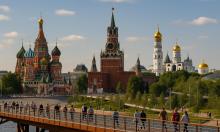Young Soviet Heroes Will Always Remain in People’s Memory
Soviet people fought with fascists till the very last drop of blood
The history of the Soviet anti-fascist organization Young Guards (Molodaya Gvardiya) ended up 60 years ago, in February of 1943. Some of its members suffocated in a mine, others were shot. They were called national heroes several years later. Soviet people called ships and even towns in honor of that association. It happened only years later after they all died. There was even a town built in the USSR, it was called Young Guards Town (Molodogvardeysk). Well-known Soviet writer Alexander Fadeyev wrote a novel about the organization, and the whole Soviet Union was so very fond of reading that book. Such names as Oleg Koshevoy, Ulyana Gromova, Sergey Tyulenin became heroic names in the Soviet Union. These names were extremely popular in the country at that period of time, and there was no Soviet citizen, who did not know them. But again, it happened later.
A small Komsomol organization Young Guards consisted of only a hundred people. Young Guards were based in the small mining town of Krasnodon. Tortures could not break young people’s courage. Fascists threw 70 bodies in the mine on January 15, 16, and 31, 1943. The mine was 50 meters deep. The leaders of the Young Guards association (Koshevoy, Shevtsov, Ostapenko, Ogurtsov, Subbotin) were brutally tortured and shot on February 9th, 1943 in the forest near the settlement of Rovenki. Only eleven young guards managed to save their lives and run away from the fascist police. Everyone else from the Young Guards group were shot by fascists. Some of them died on the front later.
Young Guards association was rather active during the entire time of the Nazi occupation in Ukraine’s Donbass (which is known for its rich coal fields). When fascists occupied the town of Krasnodon in July of 1942, there were several anti-fascist young groups formed there. The organization Young Guards was set up on October 2 of 1942, after the joint meeting between the leaders of all those youth organizations. Originally, the organization counted 91 people.
Young Guards did their best to prepare an armed rebellion. Young people wanted to achieve their major goal – to defeat the fascist garrison and to join the Soviet Army. This might have become real, if there wouldn’t have been a traitor to ruin the plans. The youth anti-fascist association was destroyed, but those people managed to do a lot anyway. Nazis sensed their presence everywhere. Young Guards hung Soviet flags all over their occupied town on the threshold of the 25th anniversary of the Great October Revolution. Young partisans helped concentration camp prisoners to escape, they burned a fascist labor exchange, which saved about two thousand Krasnodon residents from fascist slavery.
“Young Guards,” the book by Alexander Fadeyev, has become something like the Holy Writ for generations of the Soviet youth. Vladimir Chistyakov from the city of Voronezh says: “I was born in a common Soviet family. I read Alexander Fadeyev’s book “Young Guards,” when I was 20 years old, I was a freshman student. The book impressed me a lot. When I was reading the novel, it seemed to me that I was there with Oleg Koshevoy and Ulyana Gromova, fulfilling our tasks, fighting with Nazis. I was struck with the deep and pure sense of patriotism that young people had during the period of the Great Patriotic War. After I finished the book, I made up my mind to set up a youth organization like that.”
Russian inter-regional public organization Young Guards was established in Voronezh in 1999.
On the photo: The monument to Young Guards organization
Sergey Stefanov PRAVDA.Ru
Translated by Dmitry Sudakov
Subscribe to Pravda.Ru Telegram channel, Facebook, RSS!





